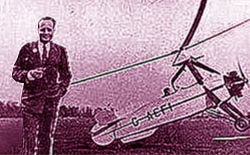|
Juan de la Cierva, Spanish inventor, did it in 1911, only 8 years after the Wright brothers. Juan de la Cierva Codorniu was born in Murcia, Spain, on September 21, 1895. He had been interested in airplanes since he was a child, and in 1910, aviator Julien Mamet’s aerial exhibition in Madrid marked his destiny. The following autumn, he and two friends of the same age began to construct their own airplane, and baptized it as BCD.1, initials of their last names: Barcala, Cierva, and Diaz. In August of 1912, at the Cuatro Vientos aerodrome in Madrid, the French pilot Jean Mauvais manned the airplane built by 16-year-old boys and, to everyone’s surprise, it was the first Spanish airplane to fly well.
After finishing his career at the School of Engineers of Caminos de Madrid, de la Cierva continued to build airships but with very little luck: one of his models even crashed; the pilot miraculously survived. Strongly affected by this accident, he dedicated his efforts to design a safer airship, with rotating instead of fixed wings. Thus was born the Autogiro, name he registered and by which is known this type of air vehicle even today. On January 17, 1923, after three years of intense work and investing a good part of the family fortune, the Autogiro C4 finally took off in Getafe aerodrome in Madrid and flew satisfactorily. Only 20 years after the invention of the airplane, the Spanish engineer Juan de la Cierva Codorniu created a safer and more practical way of flying that opened the door for the appearance of the helicopter, two decades later. In 1924, with the C6, the first Autogiro flight between airports was carried out, from Cuatro Vientos to Getafe.
In 1926, La Cierva obtained financial support from the city of London and constituted The Cierva Autogiro Company Ltd. that would provide the technical and financial means to develop the Autogiro and commercialize the manufacturing licenses. On September 18, 1928, with the C9 Mark II, Juan de la Cierva flew from London to Paris and prolonged the voyage until Brussels, Berlin and Rotterdam, with stopping points in many other cities. In 1929, Harold Pitcairn founds the Autogiro Company of America, in Philadelphia, with the same objectives as the English firm. In 1931 begins the commercialization of the Autogiro as the safest and simplest airship to pilot, with the additional advantage of requiring smaller aerodromes.
The first vertical take-off exhibition was carried out with an unprecedented success in 1936, near London. Presently an American enterprise has undertaken the project of commercializing the double Autogiro and hopes to have great success, since it is cheaper than the helicopter and requires much less fuel. And at the end…Oh, paradox of destiny! He who built airships with safety as a motto dies in an unfortunate accident in a regular airplane flight between London and Amsterdam on December 9, 1936, at the age of 41. Juan de la Cierva stands on his own right among the greatest in the universal history of aeronautics. Juan de la Cierva, an example of the best of the latin spirit. |
|
|
 Could
a 16-year-old kid design and construct, almost 100 years ago, an
airplane that flew perfectly?
Could
a 16-year-old kid design and construct, almost 100 years ago, an
airplane that flew perfectly?